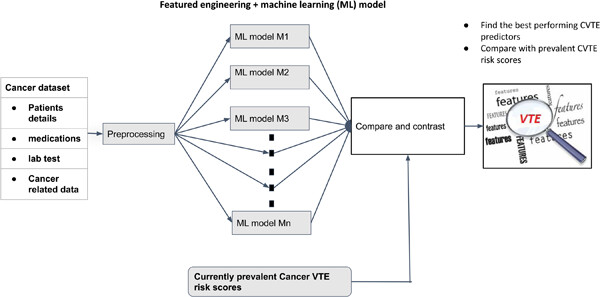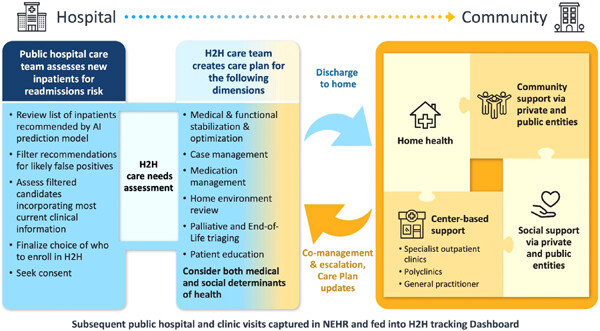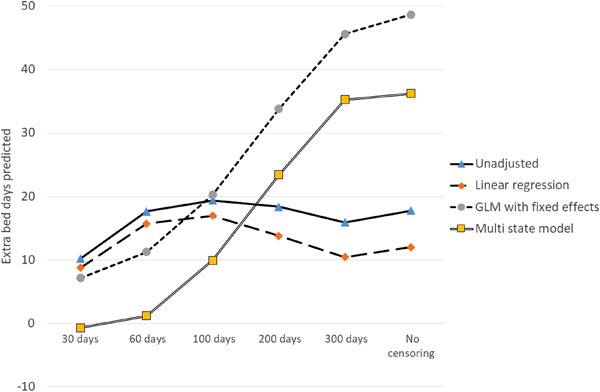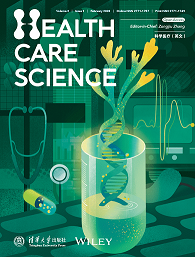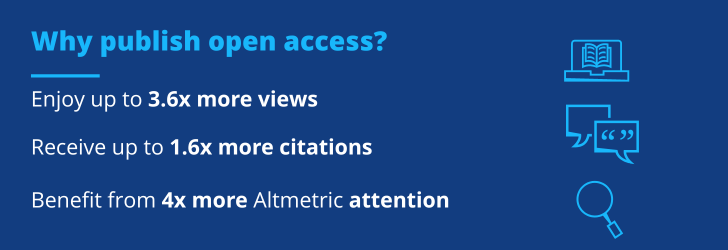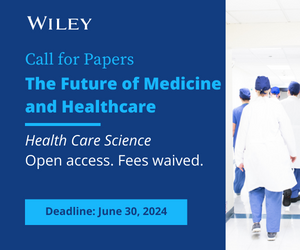Honorary Editors-in-Chief: Jiefu Huang and Tien Yin Wong; Editor-in-Chief: Zongjiu Zhang
Tsinghua University Press
Journal list menu
Introducing Health Care Science, the first scientific journal featuring the impact of technology innovation on advancing health care management and medical service, globally.
Health Care Science is an open access platform for researchers, scholars, administrators, and innovators to share their research in the quality, evaluation, and technology of healthcare service delivery, healthcare management, and healthcare policy on a scientific basis.
News
Articles
Animation‐guided family empowerment program on perioperative care after neurosurgery: A randomized controlled trial for preventing respiratory complications
- 28 April 2024
Graphical Abstract

An animated nursing education program employed to prepare pediatric caregivers for perioperative care by providing training of the manual vibration method was an effective way for enhancing the knowledge of caregivers and reducing the need for treatment of post-surgery respiratory complications. Participants in the animated educated group achieved significantly higher correct rates in questionnaires assessing acquired knowledge and patients had a significantly shorter time of atomization treatment than those in the oral educational group. Such interventions are inexpensive, pragmatic, efficient, and potentially enhance the ability of a caregiver to comprehend important information related to perioperative care needed to accelerate postoperative recovery of children.
The novel hierarchical clustering approach using self‐organizing map with optimum dimension selection
- 88-100
- 11 April 2024
Graphical Abstract

Data clustering is an important field of machine learning having applicability in wide areas, like, business analysis, manufacturing, energy, healthcare, and travel and logistics. Since no clustering method can address every clustering problem, a number of clustering algorithms with a variety of applications have been developed. Data clustering approaches based on self-organizing map (SOM) generally use the map dimensions (of grid) ranging from 2 × 2 (4 neurons) to 8 × 8 (64 neurons) without any explicit reason for using the particular dimension. Also these dimensions of SOM are not capable of giving optimized results because they lack concrete idea or logic behind using the particular dimension. Further, the number of neurons (microclusters) in the above approach is extending from 4 to 64, or any arbitrary value. Therefore these algorithms have to again use some secondary approaches to map these microclusters into the lower dimension (actual number of clusters) like 2, 3, or 4, as the case may be, based on the optimum number of clusters in the specific data set. Additionally, it is discovered that this secondary approach, observed in most of the works, is not SOM and, is an algorithm, like, cut tree or the other. In the current article, the proposed approach is elucidating a logic that will give an idea to select the most optimized dimension of SOM for the given data set. Then this optimum dimension is again clustered into the lower actual dimension. Also, primary and secondary, both approaches utilize the SOM itself to clusterize the data. It is also discovered that the weight matrix of SOM is useful in finding the best suitable dimension for the specific data set. It is to be noted that the optimized two-dimensional configuration of SOM is not the same for every data set, and this work also tries to discover this configuration. The current work proves that SOM is superior to any other clustering approaches, like, k-means or the other, and could be used successfully to clusterize all types of data sets. Seven data sets from diverse domains like medical, biological, and chemical are tested in this work, including the synthetic data sets. The adjusted randomized index obtained on the Iris, Wine, Wisconsin diagnostic breast cancer, New Thyroid, Seeds, A1, and Imbalance is, respectively, 0.7173, 0.9134, 0.7543, 0.8041, 0.7781, 0.8907, and 0.8755, which outperforms all other results on each of the data sets available on the web. The main aim of the current work is to explore the data of the medical domain but to clarify our approach, the algorithm is tested on the data of nonmedical domain and observed excellent results on them also.
The role of community pharmacists and their perception towards antimicrobial stewardship in Baghdad, Iraq
- 114-123
- 11 April 2024
Socioeconomic support, quality of life, and prognosis of frailty among the older adults
- 101-113
- 25 March 2024
Graphical Abstract

Based on the largest cohort of the longevous Chinese, the present study comprehensively evaluated the impacts of main contributors of socioeconomic support on the quality of life and prognosis of frailty. The prefrail and frail population were vulnerable to socioeconomic support and more sensitive to it than the robust population. Continuing to work at the advanced age was the risk factor of low quality of life but was the protective factor of worsening of prefrailty and survival. In sum, the present study provides evidence about socioeconomic support and prognosis of frailty for the clinical guidelines and policy makers. Frailty-preferential policies on financial and social support and medical insurance should be developed.
Building sustainable capacity for better access to diabetes care in low‐resource settings: A critical review of global efforts and integrated strategies
- 131-139
- 25 March 2024
Graphical Abstract

The alarming state of global insulin access in low resource settings presents a major barrier to diabetes care for patients living with diabetes. A comprehensive review of these challenges is lacking at the global level. To address the weakness, enhance affordability and build capacity for a more sustainable approaches to scaling up access. This review analyzes the specific issue of inconsistent access to insulin in low and middle-income countries. By this analysis, we mapped the scope and intensity of the issue and identified innovative and integrative strategies to increasing and securing accessibility.
Diagnosis and treatment protocol for COVID‐19 patients (Trial Version 9)
- Health Care Science
- 14-28
- 12 July 2022
Two Singapore public healthcare AI applications for national screening programs and other examples
- Health Care Science
- 41-57
- 19 August 2022
Graphical Abstract

This article explains how two AI systems have been incorporated into the everyday operations of two Singapore public healthcare nation-wide screening programs. Ways in which healthcare needs and the clinical operations context influenced the approach to designing or deploying the AI systems are highlighted, illustrating the multiplicity of factors that shape the requirements for successful large-scale deployments of AI systems that are deeply embedded within clinical workflows.
Decision‐making for early major amputation in selected diabetic foot ulcer patients with peripheral vascular disease
- Health Care Science
- 58-68
- 19 September 2022
Graphical Abstract

For some patients with concurrent diabetic foot ulcer and peripheral vascular disease, a major amputation is inevitable. Delaying this procedure due to fear, stigma, or other relevant reasons imposes costs on health services, patients, and those who care for them. If timely amputation is achieved for all patients who will need an amputation, then many resources and costs will be saved and can be used for other purposes.
Diagnosis and treatment protocol for COVID‐19 patients (Tentative 10th Version)
- Health Care Science
- 10-24
- 23 February 2023
A systematic review on the cost‐effectiveness of the computer‐assisted orthopedic system
- Health Care Science
- 173-185
- 2 November 2022
Graphical Abstract

In the era of precision medicine, the computer-assisted orthopedic system is fast growing. This review summarizes the cost-effectiveness analyses with regard to computer-assisted orthopedic system and explores the potential factors that would influence the cost-efficiency of this new-generation technique.
Scientific and targeted prevention and control measures to optimize COVID‐19 response
- Health Care Science
- 1-6
- 12 January 2023
Prevention and control measures to further optimize COVID‐19 response
- Health Care Science
- 7-9
- 15 January 2023
Automated labelling of radiology reports using natural language processing: Comparison of traditional and newer methods
- Health Care Science
- 120-128
- 24 April 2023
Graphical Abstract

There are four main methods employed in the automated labelling of radiology reports, namely: (1) rules-based text-matching algorithms, (2) conventional machine learning models, (3) neural network models and (4) Bidirectional Encoder Representations from Transformers (BERT) models. This paper explains the necessary data preprocessing steps, reviews the main methods for automated labelling and compares their performance.
Preparedness of South Asian countries regarding Langya virus emergence: A view on the current situation
- Health Care Science
- 194-197
- 18 April 2023
Evolution and major changes of the diagnosis and treatment protocol for COVID‐19 patients in China 2020–2023
- Health Care Science
- 135-152
- 17 May 2023
Large language models in health care: Development, applications, and challenges
- Health Care Science
- 255-263
- 24 July 2023
Graphical Abstract

The advancement of large language models (LLMs) promises to bring significant changes in health care, with extensive applications spanning pre-consultation, diagnostic, and management phases. Moreover, LLMs hold potential utility in medical education and medical writing. Concurrently, it is imperative to recognize the limitations of LLMs, strengthen review measures and enhance supervision system, thereby facilitating more effective collaboration between related personnel and LLMs.
The development and impact of adopting electronic health records in the United States: A brief overview and implications for nursing education
- Health Care Science
- 186-192
- 1 November 2022
Two Singapore public healthcare AI applications for national screening programs and other examples
- Health Care Science
- 41-57
- 19 August 2022
Graphical Abstract

This article explains how two AI systems have been incorporated into the everyday operations of two Singapore public healthcare nation-wide screening programs. Ways in which healthcare needs and the clinical operations context influenced the approach to designing or deploying the AI systems are highlighted, illustrating the multiplicity of factors that shape the requirements for successful large-scale deployments of AI systems that are deeply embedded within clinical workflows.
Xenotransplantation—reflections on the bioethics
- Health Care Science
- 86-92
- 12 October 2022
Balancing medical innovation and affordability in the new healthcare ecosystem in China: Review of pharmaceutical pricing and reimbursement policies
- Health Care Science
- 381-391
- 11 December 2023
Graphical Abstract

China has the biggest medical insurance program in the world with coverage of 95% population, with tremendous pressure on cost control. Since 2015, China's healthcare ecosystem has been reshaped by the rising China innovation, driven by regulatory reform, enhancement of R&D capability, and capital market development. How to balance affordability and innovation will be critical for China to continue the trajectory.
Ethical and policy considerations for organ trafficking and transplant tourism: Based on the UK's first international case of human trafficking for the purpose of organ removal
- Health Care Science
- 339-344
- 10 October 2023
Graphical Abstract

This study analyzes UK verdicts in an international organ trafficking case in May 2023, highlighting the involvement of national political officials and complex social factors. It emphasizes the need for a broader discussion of organ trafficking beyond areas of common criticism and discusses the ethical and policy implications of organ transplant tourism.
Diagnosis and treatment protocol for COVID‐19 patients (Tentative 10th Version)
- Health Care Science
- 10-24
- 23 February 2023
Evolution and major changes of the diagnosis and treatment protocol for COVID‐19 patients in China 2020–2023
- Health Care Science
- 135-152
- 17 May 2023
Health reform in China: Developments and future prospects
- Health Care Science
- 166-172
- 27 September 2022
Graphical Abstract

The Chinese health reform did make some significant achievements since 2009. However, affordability and accessibility to primary care and public health remain to be serious concerns. Health governance reforms are necessary to address affordability and accessibility issues in the next stage of health reform.
Measuring quality of life at work for healthcare and social services workers: A systematic review of available instruments
- Health Care Science
- 173-193
- 12 June 2023
Graphical Abstract

Quality of life at work is an important and widely discussed concept in the literature. Several instruments can be used to measure it, but with regard to healthcare and social services, the existing instruments are not well known. A review of available instruments intended to capture the quality of life of healthcare and social services workers is necessary to better assess their working conditions and promote programs/guidelines to improve these conditions.








